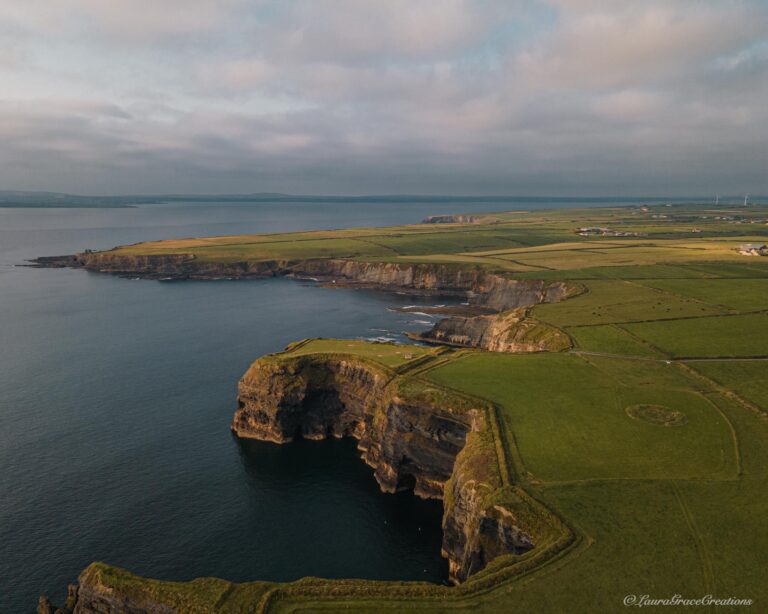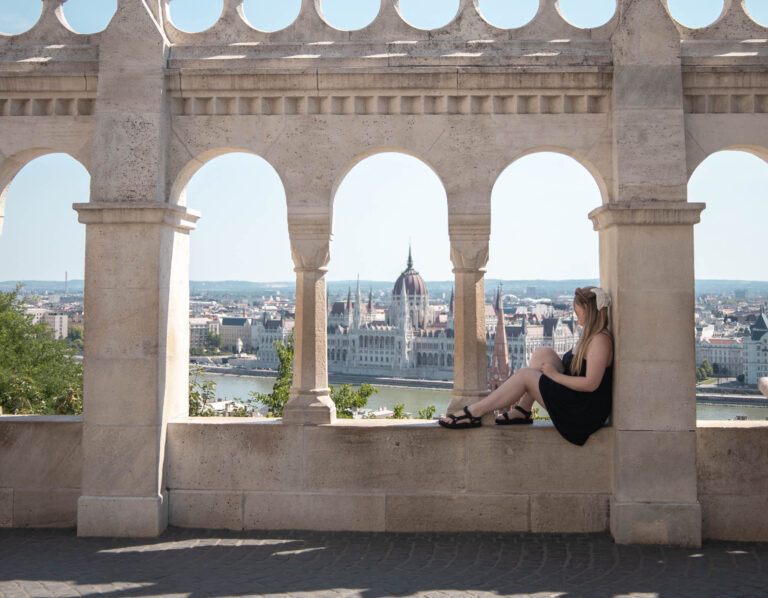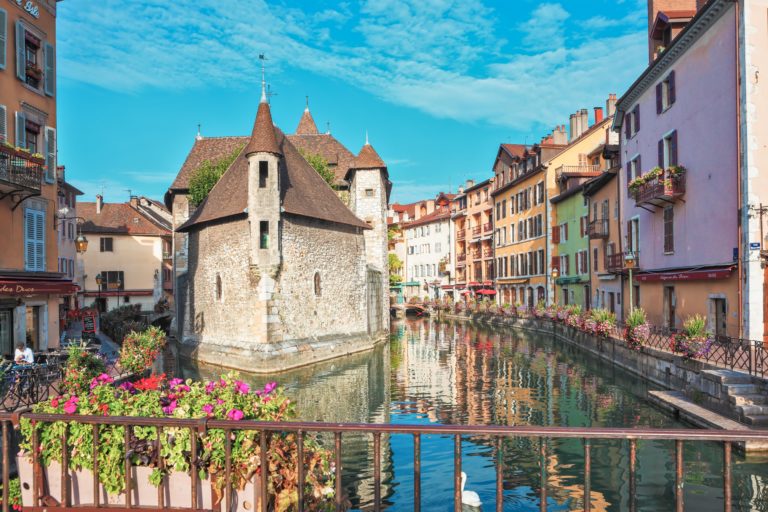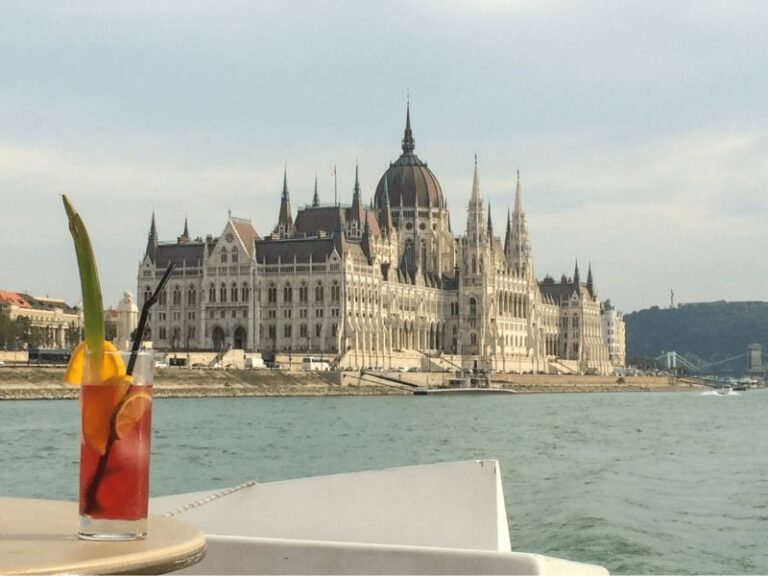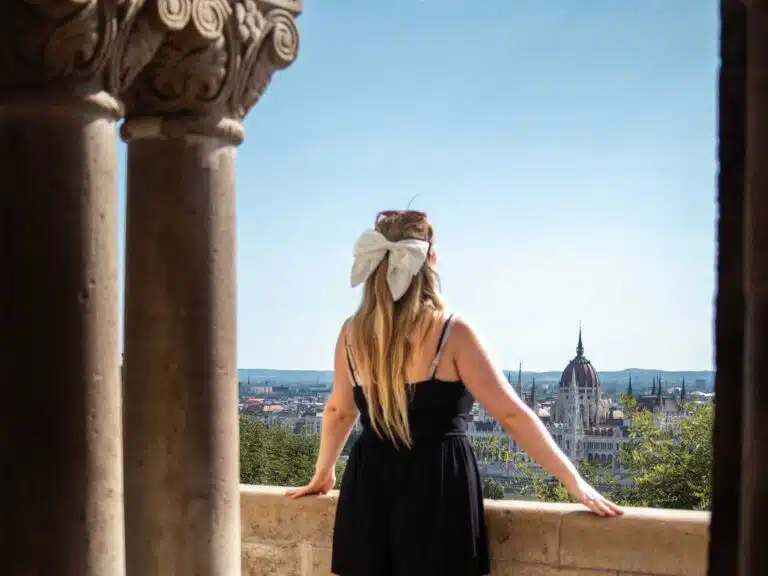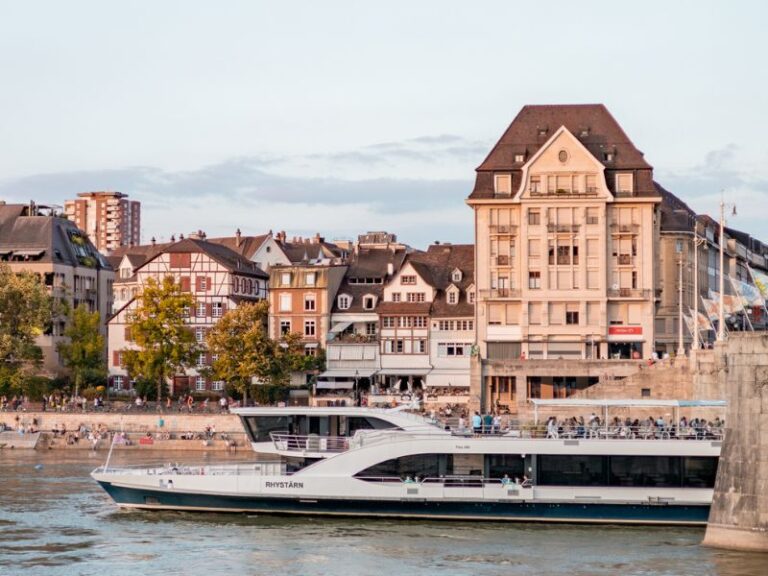2-Week Europe Itinerary by Train + 3 Different Route Options
Live Adventure Travel contains affiliate links and is a member of the Amazon Services LLC Associates Program. If you make a purchase using one of these Amazon links, I may receive compensation at no extra cost to you. See my Disclosure Policy for more information.
Europe is by far one of the best continents to travel around. It has the convenience of hopping on a train, bus or plane and arriving in a new country in a matter of hours. Yet, each place differs greatly in culture, landscape and food. It’s really like a giant playground for adults! But deciding on a 2-week Europe Itinerary by train can be a daunting task. Especially when there are multiple routes to choose from.
You have to take into consideration logistics, travel arrangements and budget. And believe me, it can be easy to find yourself pulling your hair out when it becomes clear that travelling from Paris to Budapest will take over 18 hours!

So, let me be your guide. I spent 4 months interrailing around Europe, testing some of the finest destinations on the continent. So, safe to say I see myself as somewhat of an expert when it comes to designing itineraries.
I have carefully put together 4 kickass two-week Europe Itineraries for you to explore. There is something for everyone, from city buffs, to nature lovers and hidden gem seekers!
2 Week Trip Europe: Table of Contents
Best way to Travel Europe in 2 weeks – Getting Around
Now, before we dive into the itineraries we need to discuss the best mode of transport. Europe is quite easy to get around you have the luxury of trains, planes, boats and busses right at your fingertips. But…what is the best transport option to choose?
Let’s lay out the pros and cons of each…
Plane Travel: Being from Ireland plane travel is one of the only convenient options for me to reach most European countries but once I am on the mainland I stay clear of it. It can get expensive QUICK and no one wants to waste an entire day travelling to and from the airport.
Train Travel: This is by far my favourite way of getting around Europe. It’s quick, it’s cheerful and extremely convenient. I like the space I have on a train. The ability to get up and walk down the aisle on long journeys and the incredible views along the way. I am also a big fan of the interrail system which I will explain more about a little later in this post.
Bus Travel: This is definitely the most budget-friendly way of exploring Europe. Bus journeys can be extremely cheap but that is pretty much it. They also tend to be really long, uncomfortable and a very indirect way of getting to a destination. Don’t get me wrong I do use busses while in Europe but not as my main mode of transportation. And I don’t think it should be yours either!
Driving: I am a massive road trip fan. Nothing beats, blaring your favourite road trip tunes and the freedom of having your own set of wheels to take you from A to B. But, I don’t believe a car is the best way to travel Europe over a 2 week period. Trains are much more convenient and cover way more ground at a much faster rate.
2-week Europe itinerary: By train is the best way!
So, there you have it the best way to explore Europe is by train but that leaves us with one other question. Should you book each trip individually or buy a prepaid ticket like Interrail?
There are pros and cons to both, you can of course put a lot of time and research into each train journey you intend to take. Watch the price and book when they are at their cheapest but personally, I find this method a little restricting.
With Interrail you are free to book your seat on the day (providing no reservation is needed – then it’s 24 hours before). The ticket is prepaid so you can get as many local/regional trains as you please and high-speed trains come at a considerable discount.
2-week Europe trip: 4 Different Itineraries
I have carefully designed 4 different itineraries for you to choose from for your two weeks in Europe. These routes feature some incredible hidden gems, beautiful landscapes and iconic cities. I go into more detail about each destination later on in the post and have provided little skip tags for those who want to read more about the itineraries that suit their needs best.
| Stop 1 | Stop 2 | Stop 3 | Stop 4 |
| Salzburg | Hallstatt | Munich | Interlaken |
| 4 Nights | 3 Night | 3 Nights | 3 Nights |
| Travel Time | 2h | 4h40mins | 6h |

| Stop 1 | Stop 2 | Stop 3 | Stop 4 | Stop 5 |
| Paris | Amsterdam | Munich | Prague | Budapest |
| 3 Nights | 3 Night | 3 Nights | 3 Nights | 3 Nights |
| Travel Time | 3h30mins | 7h30mins | 5h34mins | 7h17mins |

| Stop 1 | Stop 2 | Stop 3 | Stop 4 | Stop 5 | Stop 6 |
| Split | Zagreb | Bled | Ljubljana | Budapest | Krakow |
| 3 Nights | 1 Night | 3 Nights | 2 Nights | 3 Nights | 3 Nights |
| Travel Time | 4h15mins | 4h15mins | 1h30mins | 7h16mins | 9h7mins |

Two Week Europe Trip Budget
The Cost of a Two Week Europe Trip can vary greatly from person to person. Especially when it comes down to individual people’s style and spending habits. I have broken down an estimate of how much each category of traveller may spend on a two-week trip. From a budget-conscious person to a mid-range traveller to someone who is looking for luxury experiences.
I also have a detailed guide on how much I spend on my 4-month budget trip across Europe if you have an interest in real-life spending.
2-week trip to Europe Cost: Budget Travellers
Accommodation: Budget travellers can find hostels or budget hotels for around €25 to €60 per night depending on the countries they decide to visit. For a two-week stay, this amounts to €350-840.
Food: If you stick to cafes, takeaway food, and occasional home-cooked meals, you could spend around €15/20 per day, which sums up to €210/280 for two weeks.
Travel Expenses: Transport shouldn’t cost all too much if you intend on walking most places. I’d allow for €50 to be on the safe side.
Activities: Free city tours, hiking, or visiting free museums can keep the activity costs down to about €100.
Total for two weeks: €710-€1270
2 weeks in Europe Cost: Mid-Range Traveller
Accommodation: Mid-range hotels can cost around €100-150 per night. For a two-week stay, this would be €1400-2100
Food: If you intend on eating out for every meal then expect to pay around €10 for breakfast, €15 for lunch and €20+ for dinner. So, €45 a day will equal to €630 for a 2-week trip.
Travel Expenses: Consider spending around €300-500 for comfortable travel options. Or, you could keep costs down by walking most places.
Activities: Entrance fees for premium attractions and activities might add up to around €200-300.
Total for 2 weeks: €2530-3530
2 Weeks in Europe Budget: Luxury Travellers
Accommodation: Luxury hotels or apartments can cost €200-850+ per night, so it is hard to give a total in this category but it would range from €2800-€11900.
Food: Eating out for Breakfast, Lunch and Dinner in more expensive restaurants will set you back anywhere from €100-€150 per day. About €1400-2100 for the 2 weeks.
Travel Expenses: Private transfers or first-class train compartments could cost around €700-1000.
Activities: Private tours and high-end experiences might add up to another €500-1000 provided you are not doing them in every destination.
Total for 2 Weeks: €5400-16000
Route 1
Salzburg (Austria) ➡ Hallstatt (Austria) ➡ Munich (Germany) ➡ Interlaken (Switzerland)
2 Weeks in Europe Itinerary: Route Option 1
I wanted to kick start this 2 weeks in Europe itinerary with a really unique route. I typically see people planning European trips around the major cities and attractions. Never really leaving time for those amazing hidden gems located in some of the most beautiful places on the continent. So, if you are a nature lover who loves to explore more off-the-beaten-path locations this is the Europe Itinerary for you!
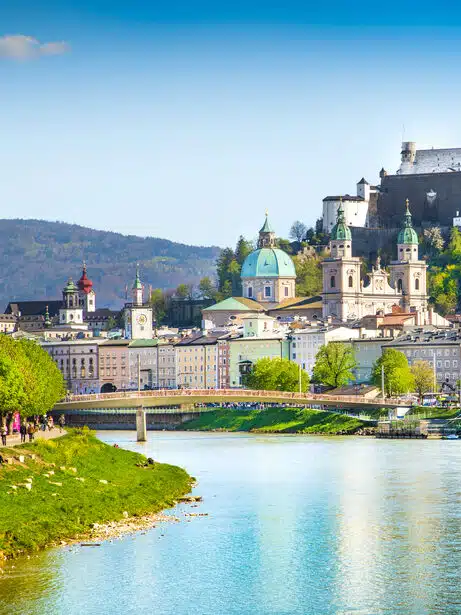
Stop 1: Salzburg
Nestled among rolling hills and overlooking the Salzach River, Salzburg, Austria, is an enchanting city filled with historic charm and modern allure.
It is the birthplace of the world-famous composer Mozart. And this is evident throughout the city.
The city has a vibrant art scene, bustling markets, and sumptuous cuisine.
Salzburg’s charm isn’t only limited to its historic architecture and vibrant streets. The city is also famously known as the filming location for the classic movie, “The Sound of Music.”
Fans of the film can dive into its magic by taking a themed tour that traces the steps of the Von Trapp family, offering a nostalgic journey through the film’s iconic sites.
Things to do in Salzburg
- Visit Mozart’s Birthplace: Discover the roots of the musical genius, one of the world’s most famous composers Mozart, by visiting his birthplace.
- Tour the Hohensalzburg Fortress: This is a must-do when in Salzburg as it has the most incredible 360 views of the city.
- Stroll through Mirabell Gardens: These beautiful gardens are a must-see for any visitor. The immaculately maintained flower beds and sculptures provide a serene place to relax. They get busy fast so make sure to visit early!
- Enjoy a Boat Ride on the Salzach River: Experience Salzburg from a unique perspective by taking a leisurely boat ride on the Salzach River.
- Indulge in Austrian Cuisine: Sample traditional Austrian dishes like Wiener Schnitzel, Sacher Torte, or Apfelstrudel to get a taste of the local culinary culture.
- Take the Sound of Music Tour: For fans of the classic film, this tour is a must. It takes you to various shooting locations of the movie, including the Mirabell Gardens and Leopoldskron Palace. You can relive your favourite scenes and enjoy the beautiful surroundings that make Salzburg so unforgettable.
Where to stay in Salzburg:
Budget:
For travellers on a budget, the YoHo Youth Hostel is a fantastic option. It’s comfortable, clean and located in city center, offering easy access to Salzburg’s attractions.
Mid-Range:
For those looking for a balance between cost and comfort, numa I Mozart is a great mid-range choice. It’s conveniently located and offers well-furnished rooms, a hearty breakfast, and friendly service, offering stellar value for your money.
Luxury:
For a truly luxurious stay, consider the Hotel & Villa Auersperg. This family-run boutique hotel exudes charm and elegance, with beautifully designed rooms, a peaceful garden, and a rooftop spa. It’s ideally located within walking distance of the city center, making it a convenient base to explore Salzburg
| Next Stop | Train Time | Train Link | Transfers |
| Hallstatt, Austria | 2h30mins | Click Here | 1 |

Day Trip Option 1: The Sound of Music Trail
One of my favourite simple day trips from Salzburg is the beautiful Sound of Music Trail starting from the small town of Werfen. Reachable by a 40-minute train journey from Salzburg.
The trail brings walkers along a stunning hiking path with opens out with an incredible view of the surrounding meadows.
This particular location is famous for the “Do Re Mi” scene from the movie. There are even dedicated photo spots where you can take a picture with July Andrews and the kids.
The walk is not particularly hard and suitable for most fitness levels. It takes about 40/45 minutes to reach the viewpoint. I recommend bringing a picnic for a scenic lunch.
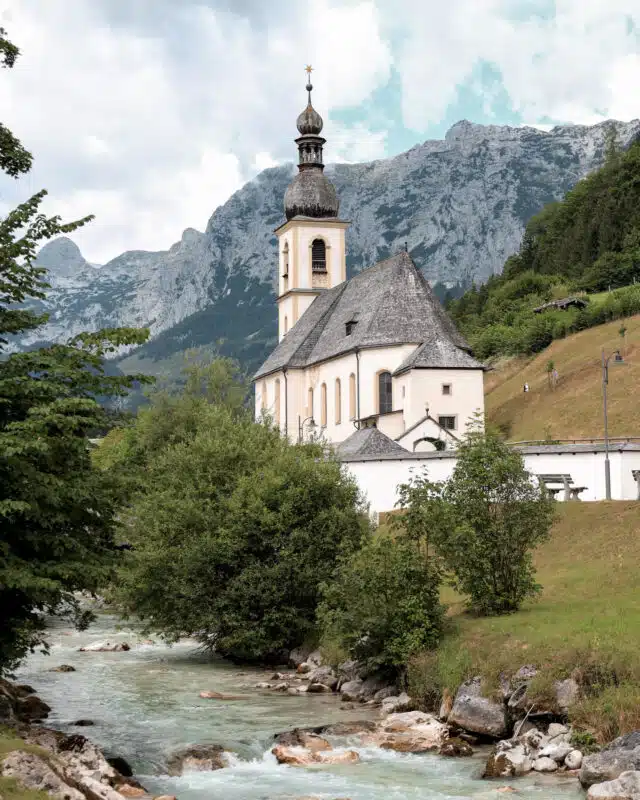
Day Trip Option 2: Berchtesgaden National Park
I fell in LOVE with Berchtesgaden National Park when I first visited. So much so that my day trip quickly turned into two.
Just over an hour’s train journey from Salzburg lies this incredible natural playground with plenty of things to do and see.
I recommend catching the boat from Königssee Lake and hiking out to the Obersee und Röthbachfall. This is a day you will not forget.
If you have another day to spare I recommend exploring the park some more. Stopping at places such as St. Sebastian Church, Hintersee Lake (walk from the church) and Wimbachklamm Gorge. All these are easily accessible by park busses.

Stop 2: Hallstatt, Austria
Hallstatt is one of those locations that will truly take your breath away. It’s one of the most fairytale-like places I have ever seen.
Home to soaring mountains, a pristine lake and a charming village. This little town can get BUSY, especially in the summer months.
So, I recommend walking up early to catch a glimpse of the famous viewpoint without any crowds. Because come 10am you will be fighting for a spot at the barrier.
Whether you’re looking for outdoor adventures, a peek into history, or simply want to enjoy the serene beauty, Hallstatt has something for everyone.
Things to do in Hallstatt
- Take a peaceful boat ride on Lake Hallstatt and enjoy the stunning views of the surrounding mountains and Alpine houses.
- Ride the funicular railway to the Skywalk Hallstatt viewing platform for a panoramic view of the beautiful village and lake.
- Explore the local market square, lined with charming, traditional shops where you can discover local crafts and delicacies.
- Explore the Dachstein Ice Caves, a fascinating natural spectacle just a short drive/bus ride away from Hallstatt.
- Take a thrilling walk on the Five Fingers viewing platform (joint ticket with the Dachstein Caves), a unique attraction sitting over 400 meters above ground level, extending like a hand over the cliff edge. Offering breathtaking views over the Alps and Hallstatt below.
Where to stay in Hallstatt
- If you prefer a peaceful setting, consider Seehotel Grüner Baum. It’s a charming hotel right on the lake.
- For those looking for a more modern option, Heritage Hotel Hallstatt offers stylish rooms with lake views.
OR
- If you are looking for somewhere that is budget-friendly consider staying in the nearby town of Bad Goisern. Located just a 10-15 minute train ride from Hallstatt station is a beautiful rural town surrounded by mountains. I stayed in the Bad Goisern Hostel and could not recommend it more. It was a lovely stay.
| Next Stop | Train Time | Train Link | Transfers |
| Munich, Germany | 5h6mins | Click Here | 1 |

Stop 3: Munich
The next stop on our trip is an amazing German city, Munich. There is more to this city than meets the eye. So, much, so that I have been 3 times and I never want to leave!
World Famous for it’s Autumn time celebrations, Oktoberfest, it’s mighty beer halls and delicious barbarian food!
When you are in Munich you NEED to visit the English gardens. Specifically, the Eisbach River to see the talented surfers glide along the waves.
Yes, that’s right! You can surf…in the city. How cool is that?!
The old town square is also a lovely place to walk around, with the Neo-Gothic-styled architecture you feel as if you are walking around a fairytale.
You also NEED to make your way up the town hall tower. The views are to die for!
Things to do in Munich
- Visit the Old Town Square, The Marienplatz. You can get 360 views of the square from the old town hall tower.
- Stroll around the English Gardens and watch the talented surfers.
- Explore the cities beautiful gardens
- Go on a local food tour to try traditional dishes like pretzels, sausages, and beer in local beer halls.
- Tour the world-famous beer hall, Hofbräuhaus. And treat yourself to a tasty beverage.
Where to stay in Munich:
For those on a budget, the Wombats Werksviertel Hostel is an affordable yet comfortable choice. It’s located near the city center, close to the main attractions, making it a convenient base for your explorations in Munich.
For those willing to spend a bit more, Eden Hotel Wolff is a mid-range option that blends comfort with a touch of luxury. It’s just a stone’s throw away from the central train station, making it an ideal location for those planning day trips to surrounding areas.
If you desire a luxury experience, consider booking a suite at Bayerischer Hof. This five-star hotel, located in the heart of Munich, offers top-notch amenities and services. From the beautiful rooftop pool to the exquisite in-house restaurant, every detail at this hotel is designed to provide guests with a memorable stay.
| Next Stop | Train Time | Train Link | Transfers |
| Munich, Germany | 6h3mins | Click Here | 1 |
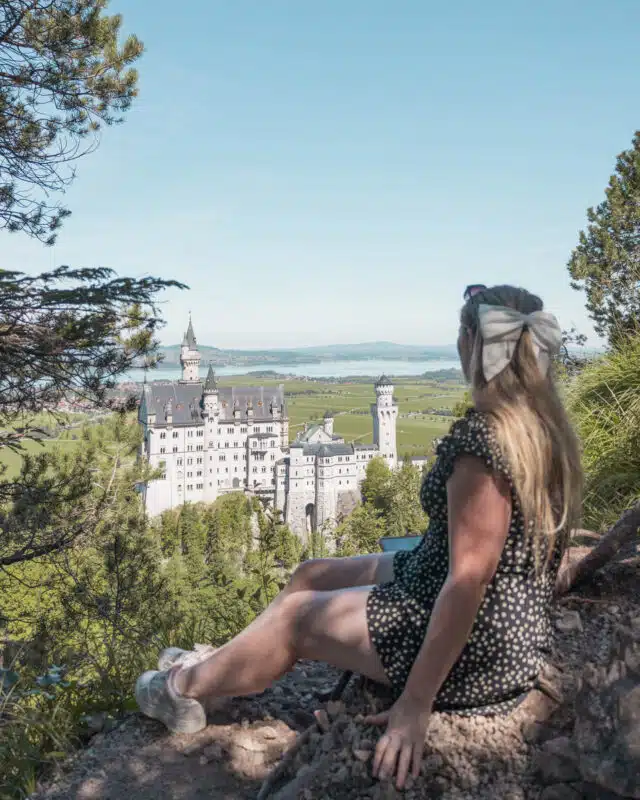
Day Trip Option: Neuschwanstein Castle
Munich is the perfect hub for those dreaming about visiting Germany’s famous fairytale castle, Neuschwanstein.
Pictures do not do this place justice. It is so beautiful.
Now, I must admit it can get incredibly busy so I’d advise arriving as early as possible.
It’s a 2h30mins train ride to Füssen, and then a short bus journey to the castle.
Once you arrive you can walk up to the famous viewpoint of Marienbrücke Bridge (30/40 minutes) or pay for a shuttle bus.
Not too far of a walk from the castle is Alpsee Lake, a beautiful spot to sit back and enjoy nature. The water is turquoise in colour and really takes your breath away.
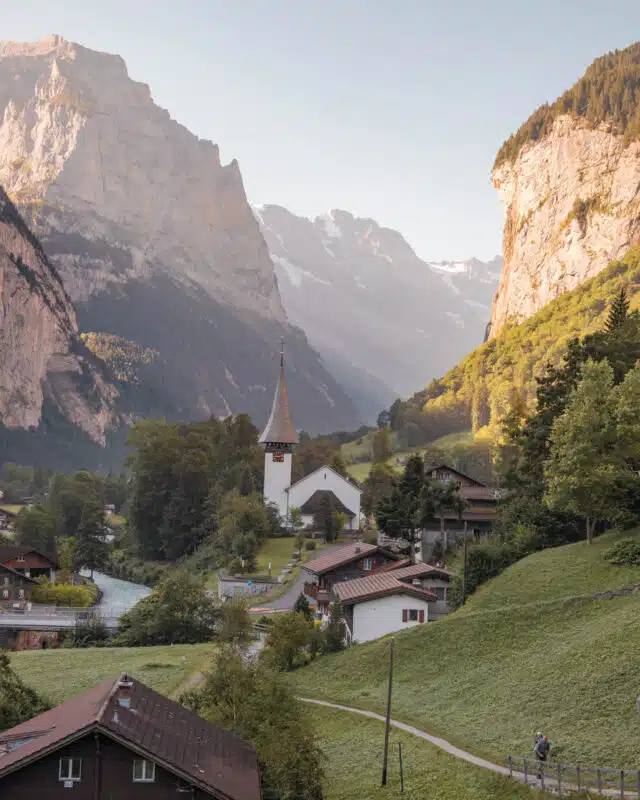
Stop 4: Interlaken, Switzerland
Switzerland left me in complete awe. I decided to visit on a speeding last-minute trip and it did not disappoint.
That is why I am advising you to include it in your 2-week Europe Itinerary. It’s a destination that almost feels like a dream.
I based myself in Interlaken and used this elegant town as a base to explore the surrounding areas.
Starting with the fairytale-like village, Lauterbrunnen. Words can not describe how beautiful it is here!
I recommend hiking from the town to Mürren, taking the cable car back down the mountain and then visiting Trümmelbach. One of the most tremendous waterfalls I have ever seen.
On day two I suggest taking a trip up First Mountain for incredible views of the mountains and valleys from above. If you are looking for an easy yet scenic walk then I recommend walking out towards Bachsee Lake.
Where to Stay in Interlaken
Backpackers in Interlaken might find Balmers Hostel a perfect choice. This hostel combines affordability with comfort and offers a warm and friendly atmosphere. I made some incredible friends here!
For those who prefer mid-range hotels, Hotel Interlaken is an excellent option and has a rich history dating back to 1491. It also offers close proximity to the town’s center.
Luxury seekers can consider Victoria-Jungfrau Grand Hotel & Spa for their stay. This five-star hotel provides an unforgettable experience with its luxurious rooms, stunning views, and world-class spa facilities.
Related Post: How big is Texas compared to Europe? (This will SHOCK you)
Route 2
Paris (France) ➡ Amsterdam (Netherlands) ➡ Munich (Germany) ➡ Prague(Czechia) ➡ Budapest (Hungary)
14 days in Europe Itinerary: Route 2
Get ready to set off on a fascinating journey through five famous European Cities. From the romantic streets of Paris to the enchanting canals of Amsterdam.
Your journey will take you to Munich, home to age-old Bavarian traditions and beer gardens. And one of the best locations for a day trip to the magical Neuschwanstein Castle. One of my favourite spots from my 4 month Europe trip!
Then, it’s time to explore the beauty of Prague with its mesmerizing architecture and picturesque streets.
Lastly, arrive in Budapest, a city known for its thermal baths and magnificent Danube River views.
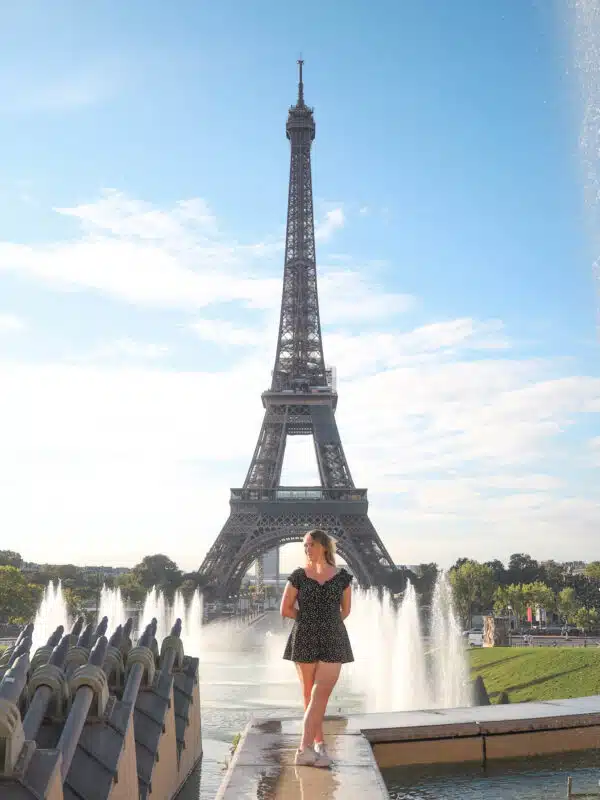
Stop 1: Paris France
Paris is known as the city of love, and that is relevant for everyone, those who visit with a significant other, friends or solo.
Because you see…one thing is for certain, you will fall in love! This bustling city’s charming streets and famous buildings capture the attention of millions of tourists each year.
With its famous art scene, fashion, and culinary delights. It’s no wonder visitors fall in love with its rich history and iconic landmarks such as the Eiffel Tower, the Louvre, and the Notre Dame Cathedral.
Adding Paris to your 14-day Europe Itinerary will leave you with a lifetime of memories. It is also the perfect starting point with its fantastic train connections to other European destinations.
Things to do in Paris
- Take a snap of the iconic Eiffel Tower.
- Explore the Louvre Museum, home to thousands of works of art, including the Mona Lisa.
- Stroll along the Seine River and enjoy a cruise for spectacular views of the city’s landmarks.
- Take a walk down the Champs-Elysées and visit the Arc de Triomphe.
- Visit Notre-Dame Cathedral and admire its magnificent Gothic architecture.
- Looking for a free 360 view of Paris then make your way up to the rooftop of Lafayette’s Shopping Centre.
Where to stay in Paris
I stayed in the People in Paris Nation and it was perfect for what I needed. I only intended on visiting the city for one day. The rest of my time I spent in Disneyland. That is why The People at Paris Nation was the perfect location for me as it’s just a 40-minute tram ride away from the parks. The only downside to the hostel is there was no kitchen. Although, this is common among all hostels in Paris. The rooms are rather spacious, with a privacy curtain on each bed. The hostel is not located in the centre of Paris and public transport is needed to get in and out of the city. However, this is common for most hostels in Paris. Overall, I’d highly recommend booking a stay in The People Hostel at Paris Nation.
| Next Stop | Train Time | Train Link | Transfers |
| Amsterdam, Netherlands | 3h30mins | Click Here | Direct |
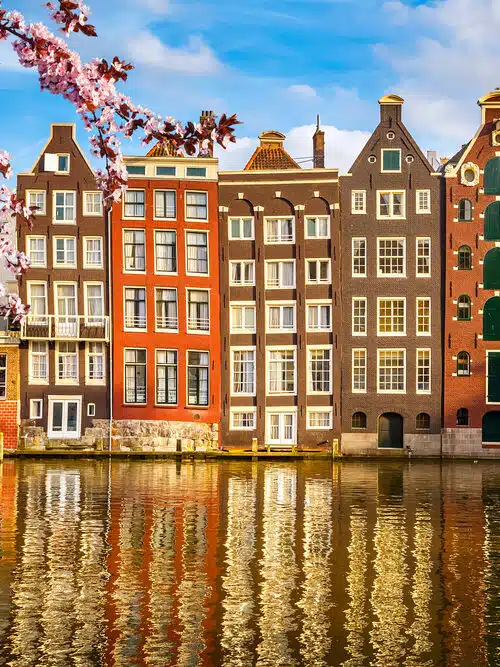
Stop 2: Amsterdam
Amsterdam is a city not to be missed. The charming streets, picture-perfect canals and heartbreaking history. It’s the ideal addition to the 2-week Europe Itinerary.
Amsterdam offers an equal blend of historical charm and a modern atmosphere.
The city’s museums house some of the world’s most famous works of art, including those of Van Gogh and Rembrandt.
A visit to the Anne Frank House provides a sad yet important insight into the city’s history, while a bicycle tour offers a unique perspective and a taste of the local lifestyle.
Whether you’re a history buff, an art enthusiast, or a foodie, Amsterdam has something to offer everyone.
Things to do in Amsterdam
- Visit the Van Gogh Museum: It houses the largest collection of Van Gogh’s paintings in the world.
- Take a Canal Cruise: Amsterdam’s canals are a UNESCO World Heritage site. A boat tour offers a unique way to see the city.
- Explore the Anne Frank House: Visit the house where Anne Frank and her family hid during World War II.
- Walk in the Vondelpark: Take a break in Amsterdam’s largest and most popular park.
- Discover the Bloemenmarkt: This is the world’s only floating flower market. You can buy all types of flowers, bulbs and souvenirs here.
Where to stay in Amsterdam:
- € – The Flying Pig Downtown: This is a lively, budget-friendly hostel located near Amsterdam Centraal railway station. It is well-known for its friendly atmosphere and social events.
- €€ – CitizenM Amsterdam: This contemporary hotel offers compact, functional rooms with all the modern amenities. It’s located in Amsterdam’s business district, a short tram ride away from the city centre.
| Next Stop | Train Time | Train Link | Transfers |
| Munich | 7h30mins | Click Here | 1 |
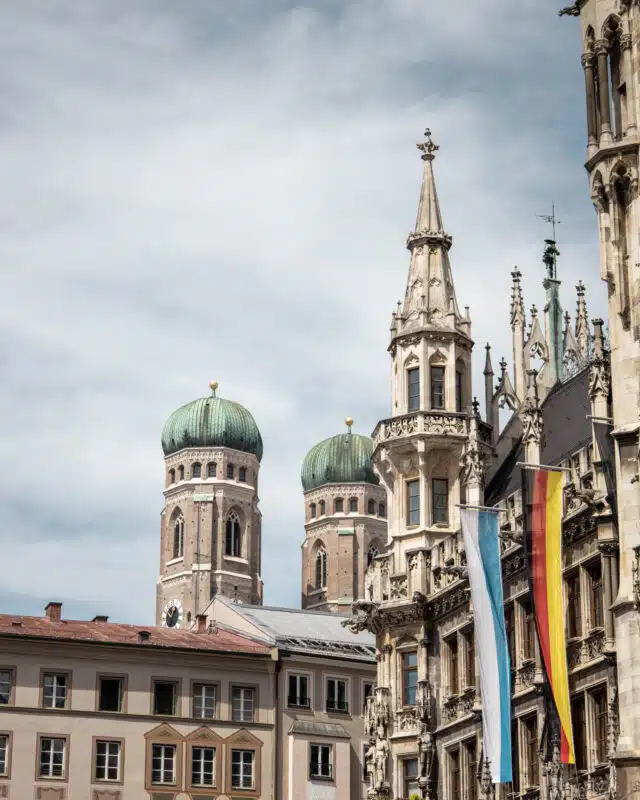
Stop 3: Munich
Munich is another amazing city that has so much more to offer than meets the eye. So, much, so that I have been 3 times and I never want to leave!
It’s famous for its Oktoberfest celebrations, beer halls and barbarian food!
One of my favourite things to do in Munich is visit the English gardens and watch the talented surfers do their thing on the Eisbach River.
Yes, that’s right! You can surf…in the city. Now that’s definitely something unique to just Munich.
The old town square is also a lovely place to walk around, with the Neo-Gothic-styled architecture you feel as if you are walking around a fairytale.
You also NEED to make your way up the town hall tower. The views are to die for!
Things to do in Munich
- The Marienplatz, Munich’s old town square is a must-visit. Especially the views from the old town hall tower.
- Stroll around the English Gardens and watch the talented surfers.
- Walk around the many amazing gardens the city has to offer!
- Savor Bavarian cuisine: Try traditional dishes like pretzels, sausages, and beer in local beer halls.
- Participate in Oktoberfest: If your visit coincides with this annual festival, don’t miss the lively beer tents, traditional music, and festive atmosphere.
- Tour the Hofbräuhaus: Visit this world-famous beer hall for a stein of beer and some hearty German food.
Where to stay in Munich:
I stayed in the Wombats Werksviertel hostel while visiting Munich. This hostel is newly renovated and has a really modern interior. The dorms are extremely spacious with curtains on the beds for extra privacy. There are two ensuites in the room which was a massive convenience.

Day Trip Option: Neuschwanstein Castle
Munich is the perfect hub for those dreaming about visiting Germany’s famous fairytale castle, Neuschwanstein.
Pictures do not do this place justice. It is so beautiful.
Now, I must admit it can get incredibly busy so I’d advise arriving as early as possible.
It’s a 2h30mins train ride to Füssen, and then a short bus journey to the castle.
Once you arrive you can walk up to the famous viewpoint of Marienbrücke Bridge (30/40 minutes) or pay for a shuttle bus.
Not too far of a walk from the castle is Alpsee Lake, a beautiful spot to sit back and enjoy nature. The water is turquoise in colour and really takes your breath away.
| Next Stop | Train Time | Train Link | Transfers |
| Prague | 5h34mins | Click Here | Direct |
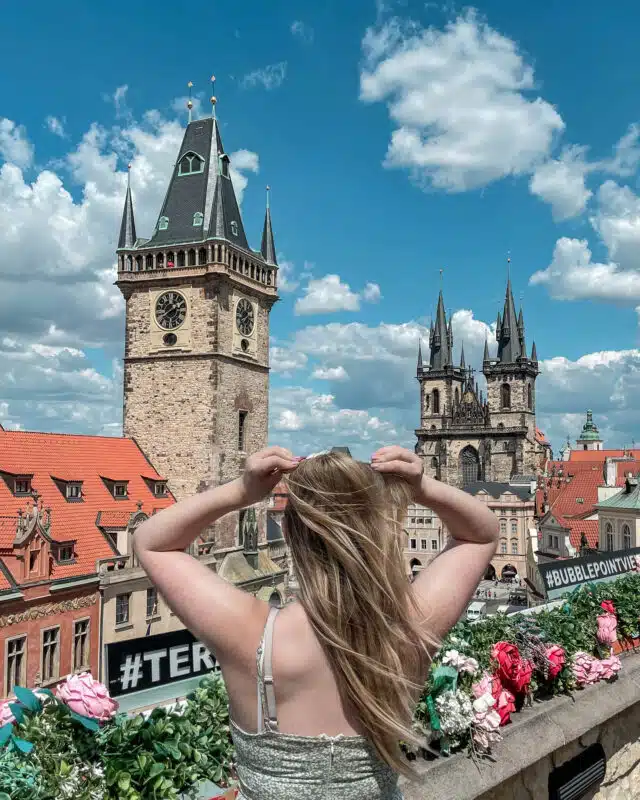
Stop 4: Prague
Prague, the capital city of Czechia, it’s a breathtaking destination steeped in rich history and culture.
The old town is extremely charming with its eye-catching architecture, featuring a mix of Romanesque Chapels, Gothic Cathedrals, and Baroque Palaces.
The city is also home to the iconic Charles Bridge, adorned with statues of Catholic saints, and the magnificent Prague Castle, which provides panoramic views of the city.
Prague is a food lovers paradise! Threat yourself to traditional Czech dishes like goulash and Trdelník – one of the tastiest deserts in Europe!
While you are there don’t forget to leave a token on love on the iconic Lennon Wall!
Things to do in Prague
- Visit Prague Castle: Explore the world’s largest ancient castle, which provides stunning views over the city.
- Stroll across the Charles Bridge: This famous historic bridge crosses the Vltava River and is adorned with statues of Catholic saints.
- Explore Old Town Square: Here, you’ll find fascinating buildings like the Old Town Hall with the Astronomical Clock, Týn Church, and St. Nicholas Church. Don’t forget to climb the tower for a 360 view of the Old Town.
- Visit the John Lennon Wall: Once a normal wall, it has been filled with John Lennon-inspired graffiti and lyrics from Beatles’ songs since the 1980s. They often have markers outside it so you can leave a message of love.
- Explore Petřín Hill: Take the funicular up Petřín Hill and enjoy the landscaped gardens and great views over Prague. This is where the Eiffel Tower of Prague lies 😉
Where to stay in In Prague
Budget Option: The Czech Inn, this is a super social hostel, the rooms are clean, the bathrooms are big and they have a shared kitchen onsite. I found it quite easy to make friends here too.
Mid Range Option: Hotel Pod Věží Located right next to the Charles Bridge, this hotel offers comfortable rooms and exceptional service at a reasonable price.
Luxury Option: The Four Seasons Hotel Prague boasts elegant rooms, a high-end restaurant, and a prime location near the Old Town Square.
| Next Stop | Train Time | Train Link | Transfers |
| Budapest, Hungary | 7h20mins | Click Here | 1 |
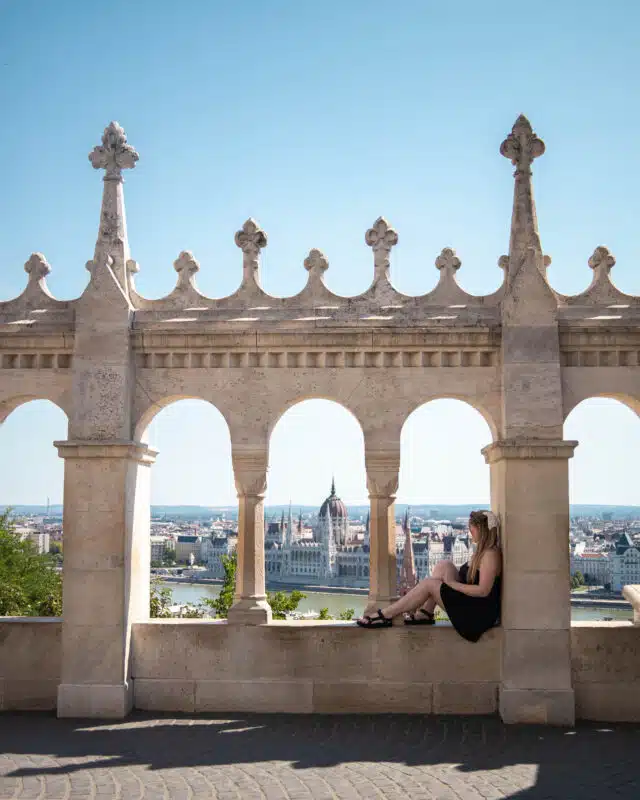
Stop 5: Budapest, Hungary
Budapest is by far one of Europe’s most picturesque cities that is 100% worth the visit. Walking around makes you feel as if you stepped straight out of a fairytale book.
The city beautifully balances the old and new. Divided in two by the Danube River, we have Buda and Pest.
Buda, the old city, is filled with historical sites like the Buda Castle and Fisherman’s Bastion, offering breathtaking views of the city.
Pest, the modern part, is a lively area with bustling markets, trendy cafes, and thriving nightlife.
Budapest is also well-known for its thermal baths where you can relax after a day of sightseeing.
Things to do in Budapest
- Explore Buda Castle: This historic castle and palace complex of the Hungarian kings offers panoramic views of Budapest.
- Visit the Fisherman’s Bastion: An architectural masterpiece that provides one of the best views of the city.
- Relax in Széchenyi Thermal Bath: Experience the city’s bath culture in this largest public thermal bath of Budapest.
- Stroll along the Danube Promenade: This scenic walkway stretches between the Elizabeth Bridge and the Chain Bridge in Pest, offering stunning views of Buda across the river.
- Visit the Hungarian Parliament Building: Marvel at the architectural beauty of this Gothic Revival-style building, which is one of the largest parliament buildings in the world.
- Take a boat tour down the Danube River to see Budapest from an alternative perspective.
- Go on a thrilling adventure by taking part in one of the city’s wonderful caving tours – one of my favourite things to do in Budapest.
Where to stay in Budapest
- Budget Accommodation: Wombats is a fantastic hostel in Budapest. It is easy to make friends, it is centrally located and in the heart of all the nightlife.
- Mid-range Accommodation: Bo18 Hotel Superior offers excellent value for money, with comfortable rooms and a good breakfast.
- Luxury Accommodation: Aria Hotel Budapest is a luxury boutique hotel with beautiful decor and a rooftop bar that offers panoramic views of the city.
Budapest is a city that has something for everyone. I can confidently say. Budapest is a destination worth putting on your European Bucket list. There is many reasons to visit for the city’s easy way of getting around, whether you choose to walk, use public transport or threat yourself to a taxi. It is incredibly safe, affordable and english is widely spoken throughout.
Route 3
Split (Croatia) ➡ Zagreb (Croatia) ➡ Lake Bled (Slovenia) ➡ Ljubljana (Slovenia) ➡ Budapest (Hungary) ➡ Krakow (Poland)
2 Weeks Europe Trip Itinerary: Route 3
This is one of the most incredible ways to spend two weeks in Europe, from the sticking beauty of the Croatian Coastline to the picture-perfect landscapes of the Julian Alpes. This route has something for everyone, from party nights in Budapest’s famous ruin bars, and romantic strolls down Venice’s winding streets to heartbreaking lessons from Poland’s past.
All of these destinations are well connected by train making them the perfect combination for your 2 weeks in Europe itinerary.

Stop 1: Split Croatia
Split is a beautiful city located on the Croatian Coast. It is known for its stunning beaches, crystal clear waters and historic heart.
It’s safe to say that this destination is a coastal paradise with plenty of nearby islands that could keep you busy for days!
The city’s narrow, winding streets are lined with beautiful old buildings that host an array of shops, cafes, and restaurants.
It’s home to a lively nightlife scene, friendly locals, and a rich history that dates back to the Romans.
It is a must-stop on any 2-week Europe itinerary and the perfect destination to kick-start your trip!
Things to do in Split, Croatia
- Explore the Old Town visiting places like Diocletian’s Palace and the Bell Tower for 360 views of the city.
- Go on a day trip, explore the nearby islands, visit the iconic blue cave or admire the beauty of Krka National Park.
- Take a hike up Marjan Hill for an alternative view of the city.
- Try Local Cuisine at Konoba Nikola. Taste authentic Dalmatian dishes at this well-loved restaurant.
Where to stay in Split
I stayed in the Enroute Hostel while in Split, it’s one I highly recommend. I made a great group of friends while I was there and it is only a 15-minute walk from the main tourist areas. The rooms are quite large in size however this didn’t really bother me as everyone has their own privacy curtain which is great if you where looking to relax for a few hours.
| Next Stop | Train Time | Train Link | Transfers |
| Zagreb, Croatia | 4h15mins | Click Here | 1 |
Stop 2: Zagreb Croatia
Zagreb is Croatia’s capital, a vibrant city steeped in history and cultural richness.
There is so much to see and do, from unique museums to quaint streets and stunning parks.
However, it is important to note, that our time in Zagreb is short. So, I recommend looking up things you would like to do while you are there.
There is something for everyone from history buffs to foodies and art enthusiasts.
Zagreb also has a bursting nightlife scene with multiple places to dance the night away.
Things to do in Zagreb
- Visit the historic Zagreb Cathedral on Kaptol, the most monumental sacral building in Gothic style southeast of the Alps.
- Explore the Museum of Broken Relationships, a quirky and unique attraction that offers a cathartic journey through the mementoes of failed relationships.
- Stroll through the vibrant Dolac Market, known as the ‘Belly of Zagreb’, where you can buy local produce and traditional Croatian specialities.
- Take a walk in Zrinjevac Park, a green oasis in the heart of Zagreb, adorned with fountains, busts of notable people, and a music pavilion.
- Enjoy a panoramic view of the city from the Lotrščak Tower, and make sure you are there at noon to witness the daily cannon firing.
Where to stay in Zagreb
I stayed in the Swanky Mint Hostel and it is the perfect spot for those who want to experience Zagreb by both, day and by night. It is very much a party hostel. It is easy to meet people in the Kitchen or by the rooftop pool (yes, they have a pool). The dorms tend to be a little cramped so I would only stay for a day or two, however, all the other hostel facilities are great. Book your stay here.
| Next Stop | Train Time | Train Link | Transfers |
| Lake Bled | 4h15mins | Click Here | 1 |
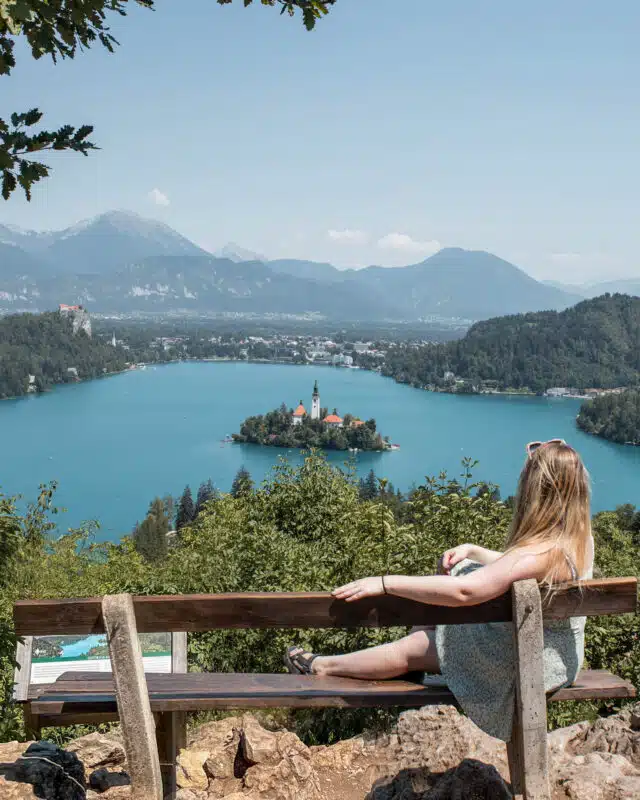
Stop 3: Lake Bled, Slovenia
Lake Bled is one of my FAVOURITE places in all of Europe. The dreamlike town is nestled in the beauty of the Julian Alps.
It is known for its stunning Castle perched on a cliff and the charming island with a church that sits in the middle of the lake.
There is so much to see and do in Bled from a simple stroll around the lake, experiencing the thrill of water sports, or simply soaking in the tranquil surroundings.
It’s a slice of paradise that promises a memorable experience to every visitor, making Bled a must-visit destination in Slovenia.
Things to do in Lake Bled
- A trip to Bled is not complete without visiting the beautiful castle that overlooks the lake.
- Rent a Plenta Boat and head towards the island in the middle of the lake. These boats are so much harder to row than you may think.
- Try Bled Cream Cake. This delicious local dessert is a must-try. It’s the perfect sweet treat after a day of sightseeing.
- The Vintgar Gorge is a must when visiting Bled. It is possible to get a bus here but honestly, I recommend walking. The views along the way are equally as stunning as the gorge.
- There are plenty of day tours of Triglav National Park. And I suggest you do at least one of them. This is such an underrated part of Europe.
Where to stay in Bled
To be honest I had an awful experience while staying in Castle Hostel in Bled. While I was there I got talking to other backpackers and everyone seemed to have issues with their hostels. If you have the budget I’d recommend checking out some more expensive options in the area.
- Hotel Triglav: Located right by the lake, Hotel Triglav offers stunning views and comfortable rooms. It’s also home to a renowned restaurant where you can sample local cuisine.
- Glamping Ribno: For a unique experience, try Glamping Ribno. Here you can stay in a luxurious tent surrounded by nature, a short distance from Bled.
- Apartments Fine Stay Bled: If you prefer self-catering, these apartments offer comfort and convenience. They come with fully equipped kitchens and are close to local amenities.
| Next Stop | Train Time | Train Link | Transfers |
| Ljubljana Slovenia | 1h30mins | Click Here | 1 |
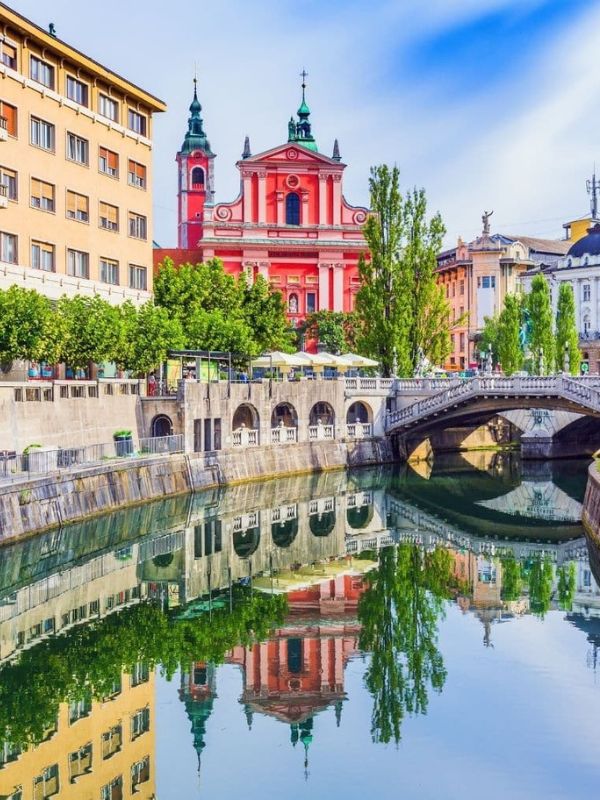
Stop 4: Ljubljana, Slovenia
Ljubljana is a city that very much surprised me. I didn’t know what to expect. It is home to charming streets, enthusiastic locals and plenty of food options.
Affectionately known as the “city of dragons,” Ljubljana is a place where rich history and tradition meet youthful energy and modern living.
The city’s iconic Dragon Bridge serves as a constant reminder of its medieval history, while the bustling open-air market and numerous art galleries give it a contemporary feel.
I know this is a destination that will steal your heart, from the cobblestone streets of the Old Town to the city’s numerous parks and green spaces. It’s a must-stop on any Europe trip.
Things to do in Ljubljana
- Explore Ljubljana Castle, an ancient fortress with a museum and observation tower offering panoramic views of the city.
- Stroll through Tivoli Park, the largest park in Ljubljana, known for its grand trees, flower beds, and beautiful sculptures.
- Visit the Dragon Bridge, an iconic symbol of Ljubljana, adorned with four dragon statues at its corners.
- Discover the Central Market, an open-air market where you can sample local Slovenian produce and traditional dishes.
- Hop on a boat tour along the Ljubljanica River for a different perspective of the city’s beautiful architecture.
Where to stay in Ljubljana
I really enjoyed my stay in Hostel Vrba, I met some of the most amazing people there, some of which I continued to travel with once I had reached bled. The hostel has a well-equipped kitchen, clean bathrooms and nicely sized dorms. The beds are comfortable and there are lockers inside the rooms with a provided lock which is always nice.
Alex the host is super friendly, she even waited for me as my train was majorly delayed and I arrived 1 hour after the last check in time. The hostel itself is located a little outside the main city, but Ljubanna is quite small and walkable so it didn’t make much of a difference.
There is shops and a bakery nearby for some cheap eats. Overall, I would highly recommend a stay in Hostel Vrba when visiting Ljubanna.
| Next Stop | Train Time | Train Link | Transfers |
| Budapest Hungary | 7h16mins | Click Here | Direct |

Stop 5: Budapest, Hungary
Budapest is by far one of Europe’s most picturesque cities. Walking around makes you feel as if you stepped straight out of a fairytale book.
The city beautifully balances the old and new. Divided in two by the Danube River, we have Buda and Pest.
Buda, the old city, is filled with historical sites like the Buda Castle and Fisherman’s Bastion, offering breathtaking views of the city.
Pest, the modern part, is a lively area with bustling markets, trendy cafes, and thriving nightlife.
Budapest is also well-known for its thermal baths where you can relax after a day of sightseeing.
Things to do in Budapest
- Explore Buda Castle: This historic castle and palace complex of the Hungarian kings offers panoramic views of Budapest.
- Visit the Fisherman’s Bastion: An architectural masterpiece that provides one of the best views of the city.
- Relax in Széchenyi Thermal Bath: Experience the city’s bath culture in this largest public thermal bath of Budapest.
- Stroll along the Danube Promenade: This scenic walkway stretches between the Elizabeth Bridge and the Chain Bridge in Pest, offering stunning views of Buda across the river.
- Visit the Hungarian Parliament Building: Marvel at the architectural beauty of this Gothic Revival-style building, which is one of the largest parliament buildings in the world.
Where to stay in Budapest
Wombats is a fantastic hostel in Budapest. It is easy to make friends, it is centrally located and in the heart of all the nightlife. It has a shared kitchen, bar and large social area on site. And the hostel is clean, well looked after and the beds are comfortable too. If I plan a trip to Budapest again I wouldn’t hesitate a stay in Wombats. Book your trip here.
DISCLAIMER: I also stayed in Flow Spaces while in Budapest on a separate occasion and honestly I had a really bad experience. I do not recommend staying here. You can read about my experience in my Best Hostels in Europe blog post.
| Next Stop | Train Time | Train Link | Transfers |
| Krakow Poland | 9h7mins | Click Here | Direct |

Stop 6: Krakow Poland
Krakow, Poland, is an extremely underrated city in Europe, it blends historical significance with youthful energy.
As one of the oldest cities in Poland, Krakow is rich in history and cultural traditions. The city’s old town, a UNESCO World Heritage site, has an elegant look to it, almost just how you would imagine a fairytale to look.
But, Krakow is steeped in a tragic past, with Auschwitz-Birkenau located just a short distance away, it is a reminder of the horrors of the Holocaust.
Despite its historical significance, Krakow is growing as a youthful city, with nearly a quarter of its population comprising students.
Things to do in Krakow
- Walk to the Wawel Castle for stunning views of the city and river.
- Krakow’s Main Market Square is the largest medieval town square in Europe, filled with historic landmarks and bustling cafes.
- Kazimierz District: Explore the vibrant Kazimierz District, once a Jewish quarter, now a hub of contemporary culture filled with galleries and music venues.
- Take a day trip to Auschwitz-Birkenau to witness a moving testament to the Holocaust.
- Admire 360 views of the city from St. Mary’s Basilica.
- Take a day tour to the famous Wieliczka Salt Mine one of the oldest mines still in operation.
Where to stay in Krakow
- Greg&Tom Party Hostel: This is a perfect spot for backpackers looking for an affordable place to stay. The hostel offers dormitory-style rooms and is located near the Main Market Square.
- Queen Boutique Hotel: Located near the Kazimierz District, this hotel offers comfortable rooms and a restaurant serving Polish and international cuisine.
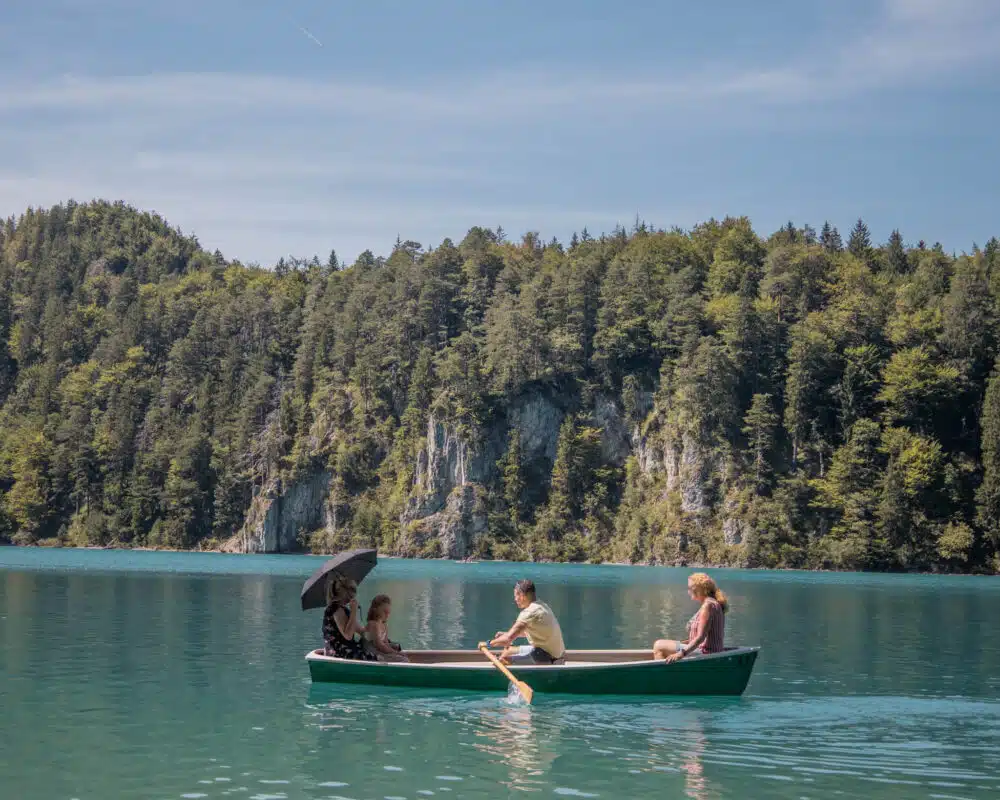
2 Weeks Europe Trip Itinerary: Tips & Advice
Plan your Transport
This may seem like an obvious one but know how you are going to get from A to B in advance. When I started my trip I was very lacked about pre-booking transport/accommodation. I wanted freedom but I quickly got caught out and was left with a booked out mode of transport.
Pre-Plan Your Route
Hopefully, this guide has given you a better idea of where you want to visit while in Europe. If there are places not mentioned here on your bucket list then I recommend double checking if it is a feasible route.
Take advantage of FREE walking Tours
Most cities and large towns have a free walking tour. These are great ways of getting a feel for a city when you first arrive. At the end of the tour you will typically tip the guide €5/10 euro as a way of saying thank you. This is a much more affordable way of seeing a destination.
Look for discounts
I was surprised to see how many attractions offered discounts, some being age-related, time-related or status-related. For example, it was common to see discounts for teachers, students or rail pass holders.
Travel in the off-season
Visiting Europe in the shoulder months is far better than in summer. The temperatures are much more enjoyable, the crowds are far less and things tend to be cheaper. May-June or September-October is a great time for a European adventure.
Be budget-conscious
Don’t presume you will naturally stay within your budget. Spending can get out of hand pretty quickly when you are not paying attention. I used my Revolut card to stay on top of what I was spending while in Europe. And it was a lifesaver.
Travel Light
You are going to be moving from place to place. So, only pack what you need to avoid sore arms and legs.
Use Local SIM cards
All EU countries allow free roaming throughout Europe (most countries). So, don’t fall for the ‘tourist SIM prices’. You should be able to pick up a sim-only plan in a local network store for about €30 with decent services.
Avoid Tourist Traps
Do some research ahead of visiting some major attractions. Some are simply not worth the time and price.
Be prepared for unexpected expenses
No matter how carefully you plan your trip, there will always be unexpected expenses that can pop up. Be prepared for these by setting aside some extra money in your budget for contingencies, and be flexible enough to adjust your plans if necessary.
Watch out for ATM Fees
Not all ATM’s charge the same withdrawal fees. I have seen some charge as much as €7 to take money out. I recommend only using machines attached to banks. They are normally the cheapest.
Research local events and festivals
You never know what is going on locally while visiting a town or city. You may be pleasantly surprised to find a free concert or event in a local park.
Prepare for tiredness
Tiredness hits you like a wave when travelling Europe. You have no clue when it will happen but I promise it will arrive at least once while on your trip.
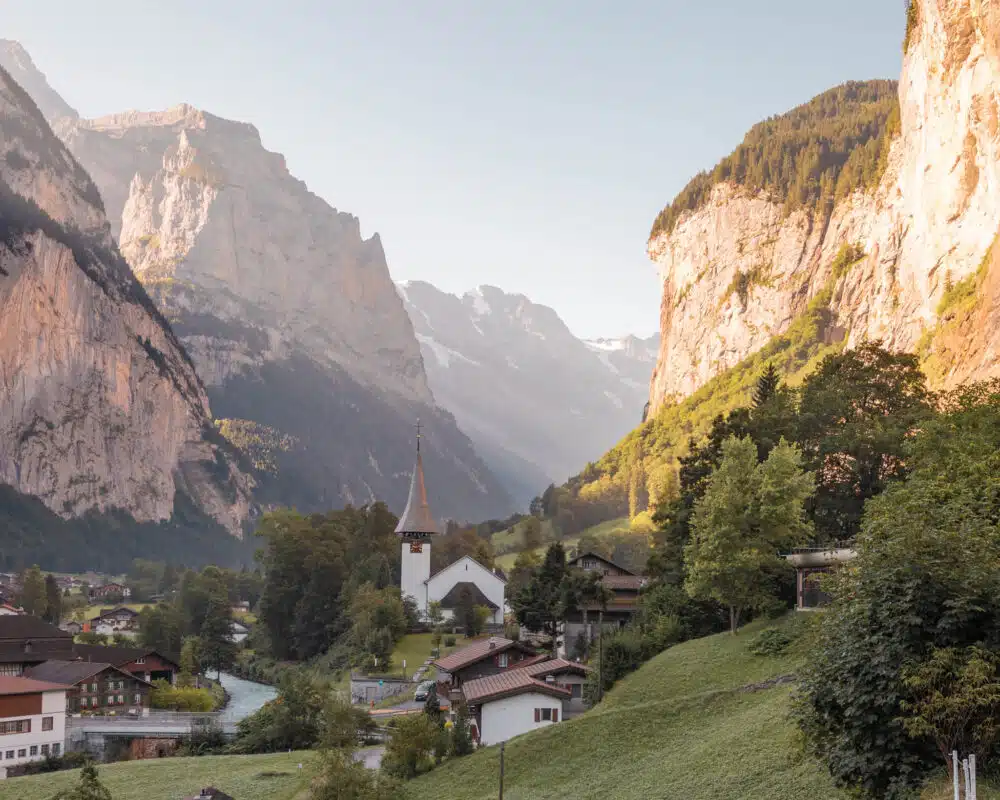
2 Week Trip to Europe Itinerary: FAQ
Is Europe Safe to Visit?
Yes, Europe is generally safe to visit. Like any travel destination, it’s important to stay aware of your surroundings and take basic security precautions. You should keep your belongings secure, be mindful of pickpockets in crowded places, and avoid walking alone at night in unfamiliar areas. Be sure to check out travel advisories for specific countries before you go. Travel insurance is also a good idea. This helps you take care of any unexpected issues like illness, injury, or theft. Happy travelling!
How expensive is Europe?
This really depends on where you intend to visit. If you spend most of your time in Eastern Europe you will spend considerably less money than you would in Northern Europe. The same goes for spending time in small villages/towns versus major cities and hubs.
My advice is to set a realistic budget and stick too it. One day you may spend a large chunk of money and then spend the next relaxing by the beach.
How much does 2 weeks in Europe cost?
This all comes down to your personal spending habits. And determined how much it costs to travel Europe for each individual person can be difficult. Below is a ballpark for 3 different types of travellers.
For those looking to explore Europe on a budget expect to pay anywhere from €710-€1270 for two weeks.
For travellers on more of a mid range budget you should budget for €2530-3530 for the two weeks.
And luxury travellers the range is quite big, expect to pay anywhere from €5400 to €16000 for two weeks of travel.
Is two weeks enough time to spend in Europe?
Two weeks can be enough to enjoy a taste of Europe, but you won’t be able to explore everything. The best approach is to focus on a few key destinations that you’re most interested in.
Plan your itinerary in a way that allows you to spend a few days in each place so you can soak up the local culture, visit main attractions, and also have some downtime.
Remember, the goal of travel is not just to see as many places as possible, but to enjoy and experience each place you visit.
How many European Countries can I visit in 2 weeks?
I would suggest visiting 4 or less countries over a 2 week period. Remember that you actually want to experience each place. The idea is not to see somewhere and then leave again a few hours later.
Is €10,000 enough for 2 weeks in Europe?
Yes, €10,000 is more than enough money for two weeks in Europe. Is it possible to spend €10,000 in this time frame. Yes, of course. But that all comes down to how well you budget. I would predict that the average person would spend between €2000-4000 on a two-week trip in Europe.
When is the Best time to spend two weeks in Europe?
The best time to spend two weeks in Europe largely depends on your personal preferences and the countries you plan to visit.
However, many agree that spring (May to June) and fall (September to October) are generally the best times.
During these periods, you can enjoy mild weather and fewer crowds. In spring, you’ll witness Europe in bloom, while autumn offers a palette of fall colours.
Summer (July and August) tends to be quite crowded, especially in popular tourist destinations, but it’s also when most festivals and events take place.
Winter (November to March) is less crowded, except during the Christmas market season, and offers the opportunity for winter sports in countries like Switzerland, France, and Austria. Remember, each season has its unique charm in Europe!
What’s the best way of getting around Europe?
Trains are a fantastic way to travel around Europe. They are fast, efficient, and often scenic, offering a comfortable journey and easy access to city centres.
Europe’s extensive rail network connects all major cities, making it convenient for inter-country travel. Plus, with a variety of rail passes available, it can also be an economical choice for those planning to visit multiple destinations.
Remember that train schedules and ticket prices can vary, so it’s a good idea to plan your journey and book tickets in advance if you don’t with a pass.
| Related Post: The ultimate travel podcast |
What currency do they use in Europe?
The currency used in Europe varies. The Euro is the most common currency, used by 19 of the 27 European Union member countries. These include popular destinations like France, Germany, Italy, Spain, and Greece.
However, some countries, including the UK and Switzerland, have retained their own currencies – the British Pound and the Swiss Franc, respectively.
Eastern European countries, such as Hungary and Czech Republic, also have their own currencies – the Hungarian Forint and the Czech Koruna.
It’s always a good idea to check the currency of the country you’re visiting before you go, and remember, credit cards are widely accepted across Europe.
Do most people speak English in Europe?
Yes, English is widely spoken across Europe, especially in major cities and tourist areas. However, the level of English proficiency can vary.
In countries like the Netherlands, Sweden, and Denmark, a large majority of people speak English very well.
In others, such as France, Italy, and Spain, you may encounter more people who do not speak English, especially in rural areas.
It’s always polite for you to learn a few basic phrases in the local language of the country you’re visiting.
Do I need a visa to travel Europe?
Whether you need a visa to travel in Europe depends on your nationality and the countries you plan to visit. For example, citizens of the United States, Canada, Australia, and New Zealand can visit the Schengen Area (which includes most European countries) without a visa for up to 90 days within a 180-day period.
But, if you’re from a country outside of this list, you may need to apply for a Schengen visa. Always check with the embassy or consulate of the country you’re visiting to get the most accurate and up-to-date information.
